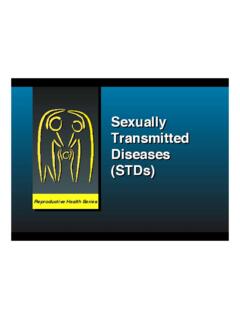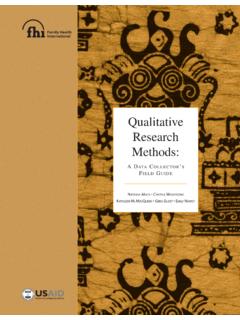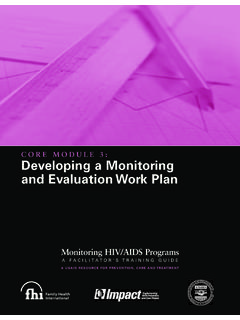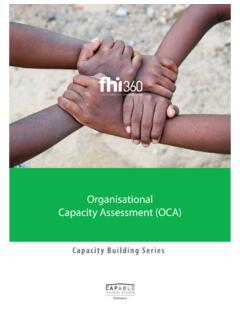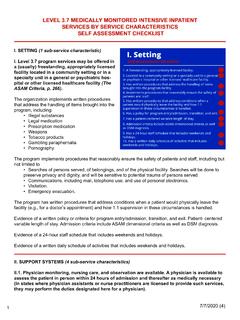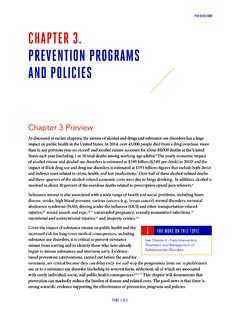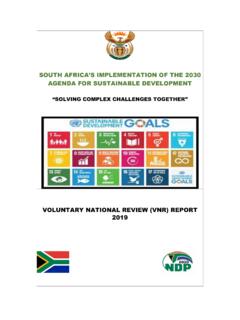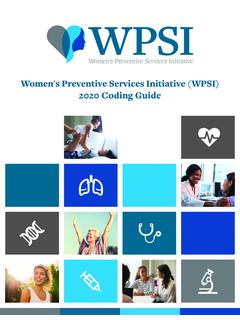Transcription of ADOLESCENT AND YOUTH SEXUAL AND REPRODUCTIVE …
1 ADOLESCENT AND YOUTH SEXUAL AND REPRODUCTIVE HEALTH TAKING STOCK IN KENYA December 2011 A Report from FHI 360/PROGRESS and the Ministry of Health, Kenya i ACKNOWLEDGEMENT This report, ADOLESCENT and YOUTH SEXUAL and REPRODUCTIVE Health: Taking Stock in Kenya, results from the collaborative efforts of the ADOLESCENT SEXUAL and REPRODUCTIVE Health Technical Working Group, the Division of REPRODUCTIVE Health (DRH), implementing partners, and development partners, with technical assistance from FHI 360/PROGRESS. We are first and foremost grateful to USAID/Kenya for commissioning and providing valuable guidance, insight and logistical support to the review team. In particular, the review team wishes to acknowledge the support and assistance of Sheila Macharia, Jerusha Karuthiru and Maina Kiranga. We are specifically grateful to Dr. Bashir, Head, DRH and Dr. Aisha Mohamed, Program Manager, ASRH, for the support they provided during the stock taking exercise.
2 They introduced the review team to the stakeholders and led all meetings related to the review. They also provided editorial and technical input on the report. The senior staff at FHI 360: Jennifer Liku, Maryanne Ombija, Dr. Marsden Solomon, Erika Martin, Bill Finger and Dr. ABN Maggwa formed the review team at FHI 360 and guided the data collection, data analysis and review of the report. Maureen Kuyoh, an FHI 360 consultant, provided assistance through the development and implementation of this report. Additionally, Ruth Gathu provided the much needed logistical support during data collection and report writing. It would not have been possible to come up with this report without the willingness and readiness of both public and private sector stakeholders, as well as development and implementing partners to share information on their AYSRH activities and the evaluations they have undertaken. We are grateful to all stakeholders who took their time to respond to the question guide and who attended the stakeholder forum to validate the data collected and provide invaluable input.
3 Finally, we wish to thank all our colleagues who reviewed earlier drafts and provided useful comments. The responsibility for the interpretation of the analysis findings rests with the review team. This project was made possible by the generous support of the American people through USAID/Africa Bureau under the terms of FHI 360 Co-operative Agreement No. GPO-A-00-08-00001-00, the Program Research for Strengthening Services (PROGRESS) project. The opinions expressed herein are those of FHI 360 and do not necessarily reflect the views of USAID. ii TABLE OF CONTENTS ACRONYMS .. iii EXECUTIVE SUMMARY .. iv INTRODUCTION .. 1 METHODS .. 3 Desk Review .. 3 Mapping of YSOs and Interview with Stakeholders .. 4 LITERATURE REVIEW .. 5 Status of ADOLESCENT and YOUTH SRH .. 5 MAPPING OF YOUTH SERVING ORGANIZATIONS AND STAKEHOLDER INTERVIEW FINDINGS .. 9 The Policy 9 Program Coverage .. 10 Program Approaches.
4 11 Important Aspects for Implementation of SRH Interventions .. 15 Gaps in AYSRH Stakeholders Perspectives .. 16 Stakeholder Recommendations .. 18 EVIDENCE-BASED INTERVENTIONS .. 18 22 APPENDIXES .. 24 iii ACRONYMS AIDS Acquired Immune Deficiency Syndrome ASRH ADOLESCENT SEXUAL and REPRODUCTIVE health AYSRH ADOLESCENT and YOUTH SEXUAL and REPRODUCTIVE health CBO Community based organization CPR Contraceptive prevalence rate DRH Division of REPRODUCTIVE Health EGPAF Elizabeth Glaser Pediatric AIDS Foundation FBO Faith based organization HIV Human Immunodeficiency Virus ICT Information and communication technology IDU Injecting drug users KDHS Kenya Demographic and Health Survey MCH/FP Maternal child health/Family Planning MDG Millennium development goals MOE Ministry of Education MOMS Ministry of Medical Services MOPHS Ministry of Public Health and Sanitation MOYAS Ministry of YOUTH Affairs and Sports NCAPD National Coordinating Agency for Population and Development NGO Non-governmental organization OVC Orphans and vulnerable children PEPFAR President s Emergency Plan
5 For AIDS Relief RH REPRODUCTIVE health SRH SEXUAL and REPRODUCTIVE health STI sexually transmitted infections TWG Technical working group UNAIDS Joint United Nations Programme on HIV/AIDS UNFPA United Nations Population Fund UNICEF United Nations Children s Fund USAID United States Agency for International Development VMMC Voluntary medical male circumcision WHO World Health Organization YFS YOUTH -friendly services YSO YOUTH serving organization iv EXECUTIVE SUMMARY The Division of REPRODUCTIVE Health (DRH) within the Ministry of Public Health and Sanitation (MOPHS) with assistance from FHI 360 and financial support from United States Agency for International Development (USAID) undertook a review of ADOLESCENT and YOUTH REPRODUCTIVE health programs in the country through a desk review, a mapping of YOUTH serving organizations (YSOs), and interviews with stakeholders from the YSOs and development partners.
6 The goal was to identify the key organizations involved in ADOLESCENT and YOUTH SEXUAL and REPRODUCTIVE health (AYSRH), compile a general inventory of their activities, and begin to assess the degree to which they are using evidenced-based interventions that are ready for national scale-up. This review was designed to enhance the DRH s ability to coordinate AYSRH activities in the country. Kenya has multiple policies and guidelines that favor provision of information and services to young people, but these documents are not integrated well into services. Multiple ministries are involved in the process, adding to the challenges in this field. In addition to the MOPHS, the key ministries and government agencies with interest in AYSRH are Ministry of Medical Services (MOMS), Ministry of YOUTH Affairs and Sports (MOYAS), Ministry of Education (MOE), National Coordinating Agency for Population and Development (NCAPD), National AIDS and STD Control Program (NASCOP), and Kenya Institute of Education (KIE) among others.
7 Out of the 67 YSOs and 13 development partners identified in the review, 45 organizations and nine development partners responded with information through a telephone interview or email. The findings reiterated the fact that many young people are sexually active and are at risk of adverse REPRODUCTIVE health outcomes that subsequently affect achievement of life goals and optimum contribution to national development. Many YOUTH initiate SEXUAL intercourse early, have multiple partners and often do not use protection during sex. In general, young people are unlikely to seek health services, and when they do they are likely to get inadequate services. This health system has been slow to evolve to accommodate the needs of this age group both from program and service delivery perspectives. Some service providers lack the skills and positive attitudes needed to serve YOUTH .
8 Most YSOs operate within the highly populated areas of the country with Nairobi having the highest concentration of implementers (26 out of the 45 interviewed). They mainly target in- and out-of-school YOUTH aged 10-24 years, in both rural and urban areas. The main program approaches they use to reach YOUTH include peer education, edutainment, service delivery (including outreach services), YOUTH support structures, mass media, ICT, edusports, life skills education, mentorship, adult influencers, and advocacy for policy review or change. These approaches are usually not implemented singly but in combination, such as peer education with mass media and service delivery. In the survey, the YSOs identified the following main gaps in AYSRH in terms of program and service delivery. v Program level: Inadequate dissemination and utilization of policies and guidelines and coordination of AYSRH activities nationally.
9 Inadequate distribution of AYSRH activities in the country; some areas or target groups are over served while others hardly have any activities. Insufficient involvement of YOUTH and communities in YOUTH activities and programs. Inadequate human and financial resources. Programs not incorporating the social and cultural context into the interventions. Insufficient scale-up of evidence-based interventions. The emerging ICT platform has not been fully embraced by programs to reach YOUTH with information. Service delivery level YOUTH -friendly services (YFS) are poorly defined leading to various interpretations. Most facilities do not have YFS. Inadequate training and orientation of service providers to provide SRH services to YOUTH . Awareness creation of available YOUTH SRH services is inadequate. Frequent shortage of commodities and supplies. Peer educators are not fully utilized.
10 In the interviews, stakeholders recommended the following: Improved coordination of AYSRH activities. Dissemination and monitoring of policies and guidelines. Application of multi-sectoral approaches to address AYSRH holistically. Integrating AYSRH into other health and non-health related activities involving YOUTH . Re-definition and standardization of YFS. Training and orientation of service providers on YOUTH sexuality and service delivery. Evaluation of promising interventions to provide evidence for scale-up. National scale-up of evidence-based interventions. Four projects were identified that are utilizing evidence-based interventions: Kenya ADOLESCENT REPRODUCTIVE health program (KARHP) Friends of YOUTH (FOY) Primary school action for better health (PSABH) Families Matter! vi AYSRH in Kenya needs to be better coordinated and monitored to effectively utilize the existing resources and support the replication of evidence-based interventions.

